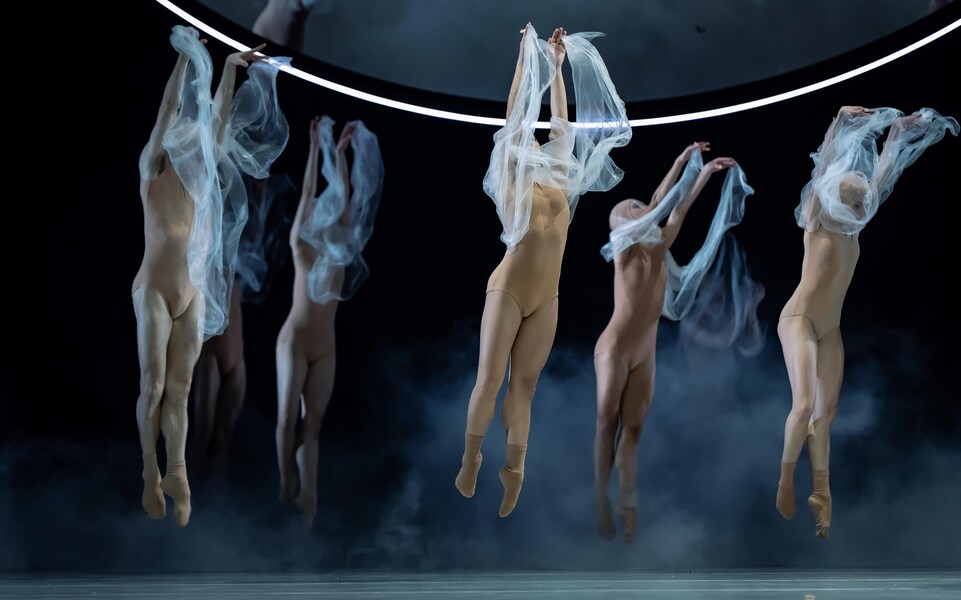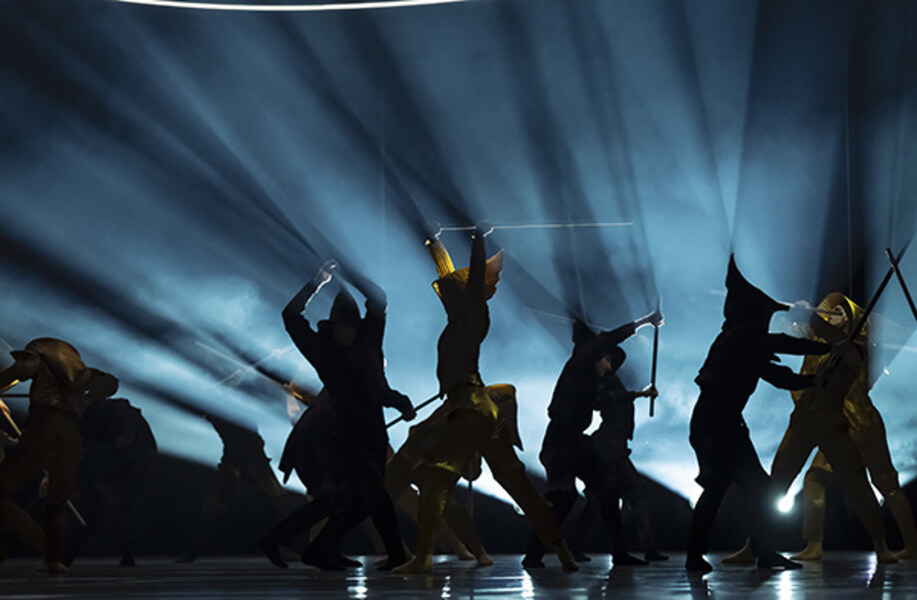The search for personal freedom, respect and acceptance.
Ballet in two acts
World premiere
Premiere
9. December 2023
Dates & Cast
- Conductor Fayçal Karoui
- Choreografie und Inszenierung Johan Inger
- Music Pjotr I. Tschaikowsky
- Produktionsdramaturgie Gregor Acuña-Pohl
- Bühnenbild mit Estudiodedos Curt Allen Wilmer, Leticia Gañán
- Costume Design Salvador Mateu Andujar
- Lighting Design Tom Visser
- Video Emilio Valenzuela Alcaraz
- Assistent to the Choreographer Zoran Markovic
- Solovioline Yuki Manuela Janke (21., 27., 27. September 2025), Matthias Wollong (01., 03., 06. October 2025)
- Zoe, Königin Duosi Zhu (21., 27. September, 03., 06. October 2025), Svetlana Gileva (27. September, 01. October 2025)
- Zeno, König Christian Bauch (21., 27. September, 06. October 2025), Johannes Goldbach (27. September, 01., 03. October 2025)
- Theo, Zoes Vertrauter Joseph Gray (21., 27., 27. September 2025), Lamin Pereira (01., 03., 06. October 2025)
- Benno, Gast und Einsiedler Jón Vallejo (21., 27. September, 06. October 2025), James Kirby Rogers (27. September, 01., 03. October 2025)
- Kallisto, Prinz Anthony Bachelier (21., 27. September, 06. October 2025), Juan Sebastián Valdez (27. September, 01., 03. October 2025)
- Odette, Schwanenjungfrau Nastazia Philippou (21., 27. September, 06. October 2025), SeoHyeon Jeong (27. September, 01., 03. October 2025)
- Gottheit / Sohn Florin Henneberg (21., 27. September, 03. October 2025), Leander Wilde (27. September, 01., 06. October 2025)
- Conductor Fayçal Karoui
- Choreografie und Inszenierung Johan Inger
- Music Pjotr I. Tschaikowsky
- Produktionsdramaturgie Gregor Acuña-Pohl
- Bühnenbild mit Estudiodedos Curt Allen Wilmer, Leticia Gañán
- Costume Design Salvador Mateu Andujar
- Lighting Design Tom Visser
- Video Emilio Valenzuela Alcaraz
- Assistent to the Choreographer Zoran Markovic
- Solovioline Yuki Manuela Janke
Generously supported by the Semperoper Foundation
- Zoe, Königin Duosi Zhu
- Zeno, König Christian Bauch
- Theo, Zoes Vertrauter Joseph Gray
- Benno, Gast und Einsiedler Jón Vallejo
- Kallisto, Prinz Anthony Bachelier
- Odette, Schwanenjungfrau Nastazia Philippou
- Gottheit / Sohn Florin Henneberg
- Conductor Fayçal Karoui
- Choreografie und Inszenierung Johan Inger
- Music Pjotr I. Tschaikowsky
- Produktionsdramaturgie Gregor Acuña-Pohl
- Bühnenbild mit Estudiodedos Curt Allen Wilmer, Leticia Gañán
- Costume Design Salvador Mateu Andujar
- Lighting Design Tom Visser
- Video Emilio Valenzuela Alcaraz
- Assistent to the Choreographer Zoran Markovic
- Solovioline Yuki Manuela Janke
Generously supported by the Semperoper Foundation
- Zoe, Königin Duosi Zhu
- Zeno, König Christian Bauch
- Theo, Zoes Vertrauter Joseph Gray
- Benno, Gast und Einsiedler Jón Vallejo
- Kallisto, Prinz Anthony Bachelier
- Odette, Schwanenjungfrau Nastazia Philippou
- Gottheit / Sohn Florin Henneberg
- Conductor Fayçal Karoui
- Choreografie und Inszenierung Johan Inger
- Music Pjotr I. Tschaikowsky
- Produktionsdramaturgie Gregor Acuña-Pohl
- Bühnenbild mit Estudiodedos Curt Allen Wilmer, Leticia Gañán
- Costume Design Salvador Mateu Andujar
- Lighting Design Tom Visser
- Video Emilio Valenzuela Alcaraz
- Assistent to the Choreographer Zoran Markovic
- Solovioline Yuki Manuela Janke
Generously supported by the Semperoper Foundation
- Zoe, Königin Svetlana Gileva
- Zeno, König Johannes Goldbach
- Theo, Zoes Vertrauter Joseph Gray
- Benno, Gast und Einsiedler James Kirby Rogers
- Kallisto, Prinz Juan Sebastián Valdez
- Odette, Schwanenjungfrau SeoHyeon Jeong
- Gottheit / Sohn Leander Wilde
- Conductor Fayçal Karoui
- Choreografie und Inszenierung Johan Inger
- Music Pjotr I. Tschaikowsky
- Produktionsdramaturgie Gregor Acuña-Pohl
- Bühnenbild mit Estudiodedos Curt Allen Wilmer, Leticia Gañán
- Costume Design Salvador Mateu Andujar
- Lighting Design Tom Visser
- Video Emilio Valenzuela Alcaraz
- Assistent to the Choreographer Zoran Markovic
- Solovioline Matthias Wollong
Generously supported by the Semperoper Foundation
- Zoe, Königin Svetlana Gileva
- Zeno, König Johannes Goldbach
- Theo, Zoes Vertrauter Lamin Pereira
- Benno, Gast und Einsiedler James Kirby Rogers
- Kallisto, Prinz Juan Sebastián Valdez
- Odette, Schwanenjungfrau SeoHyeon Jeong
- Gottheit / Sohn Leander Wilde
- Conductor Fayçal Karoui
- Choreografie und Inszenierung Johan Inger
- Music Pjotr I. Tschaikowsky
- Produktionsdramaturgie Gregor Acuña-Pohl
- Bühnenbild mit Estudiodedos Curt Allen Wilmer, Leticia Gañán
- Costume Design Salvador Mateu Andujar
- Lighting Design Tom Visser
- Video Emilio Valenzuela Alcaraz
- Assistent to the Choreographer Zoran Markovic
- Solovioline Matthias Wollong
Generously supported by the Semperoper Foundation
- Zoe, Königin Duosi Zhu
- Zeno, König Johannes Goldbach
- Theo, Zoes Vertrauter Lamin Pereira
- Benno, Gast und Einsiedler James Kirby Rogers
- Kallisto, Prinz Juan Sebastián Valdez
- Odette, Schwanenjungfrau SeoHyeon Jeong
- Gottheit / Sohn Florin Henneberg
- Conductor Fayçal Karoui
- Choreografie und Inszenierung Johan Inger
- Music Pjotr I. Tschaikowsky
- Produktionsdramaturgie Gregor Acuña-Pohl
- Bühnenbild mit Estudiodedos Curt Allen Wilmer, Leticia Gañán
- Costume Design Salvador Mateu Andujar
- Lighting Design Tom Visser
- Video Emilio Valenzuela Alcaraz
- Assistent to the Choreographer Zoran Markovic
- Solovioline Matthias Wollong
Generously supported by the Semperoper Foundation
- Zoe, Königin Duosi Zhu
- Zeno, König Christian Bauch
- Theo, Zoes Vertrauter Lamin Pereira
- Benno, Gast und Einsiedler Jón Vallejo
- Kallisto, Prinz Anthony Bachelier
- Odette, Schwanenjungfrau Nastazia Philippou
- Gottheit / Sohn Leander Wilde
In brief
After his acclaimed literary adaptations of »Carmen« and »Peer Gynt«, Johan Inger now turns to a classic ballet that will reveal yet another facet of his art: »Swan Lake«. In 2023, the Swedish choreographer has reinterpreted this great work for Semperoper Ballett and, in so doing, addressed some profound questions: How are personal relationships affected by violence and manipulation? And what roles do personal freedom, respect and acceptance play in a loving relationship?
»Der geraubte Schleier« (The Stolen Veil) from Johann Karl August Musäusʼs collection of »German Folk Stories« (1784) is believed to be one of the inspirations behind the popular narrative ballet. This fairy tale, partly set in the Ore Mountains near the »Swan City« of Zwickau, provides an exciting alternative to the traditional interpretation of »Swan Lake«. Based on this story and accompanied by a new arrangement of Pyotr I. Tchaikovsky’s music, Johan Inger has devised a choreographic reinterpretation of Musäusʼs fantastic tale revolving around the motif of the swan-maiden.
Storyline
Prologue
A deity bestows the gift of transforming into swans upon selected souls.
Act I
Queen Zoe, who with the help of a magic veil can turn into a swan, is unhappy in her marriage with King Zeno. One day Benno, a guest, arrives at their castle. He and the Queen take a liking to each other. However, the King catches them and has Benno arrested. Theo, Zoe‘s confidant, helps him escape and tells him that he can find his beloved at a faraway lake. Only once a year can the Queen fly there in order to take a rejuvenating bath. In the hope of seeing her again, Benno embarks on a journey through different countries. At the said Swan Lake they express their love to each other and promise to meet again. When Zoe returns home and arrives at a ball too late, Zeno punishes her by destroying her veil. At the lake, Benno waits in vain for his beloved.
Act II
Twenty years later, the now widowed Queen Zoe has to send her son Kallisto off to war. On the shores of the Swan Lake, of all places, he is wounded and cared for by Benno. The hermit, who has taken in the Prince like a son, initiates him into the secret of the lake and they witness the ritual of the swan people, who take their annual bath. When Benno once again does not find Zoe among the group, he dies in despair. At the same moment, Kallisto discovers the swan maiden Odette and falls in love with her. To prevent her from flying away, he steals her veil and hides it. Seeking protection, she takes the Prince for her saviour and begins a life together with him at the lake. Having searched for Kallisto, Theo eventually finds him and asks him to come back home. However, he refuses and remains with Odette and their child in the seclusion he has chosen. Increasingly suffering from Kallisto‘s violence, the life of his family changes for the worse. Just at this time, his wife rediscovers her veil and realizes that she had been deceived. This moment is also witnessed by Zoe, who has come to personally convince her son to return to court. She recognizes herself in Odette and encourages her to reclaim her freedom ...
Explore
»A Swan Lake«
A Swan Lake – Making-of
















